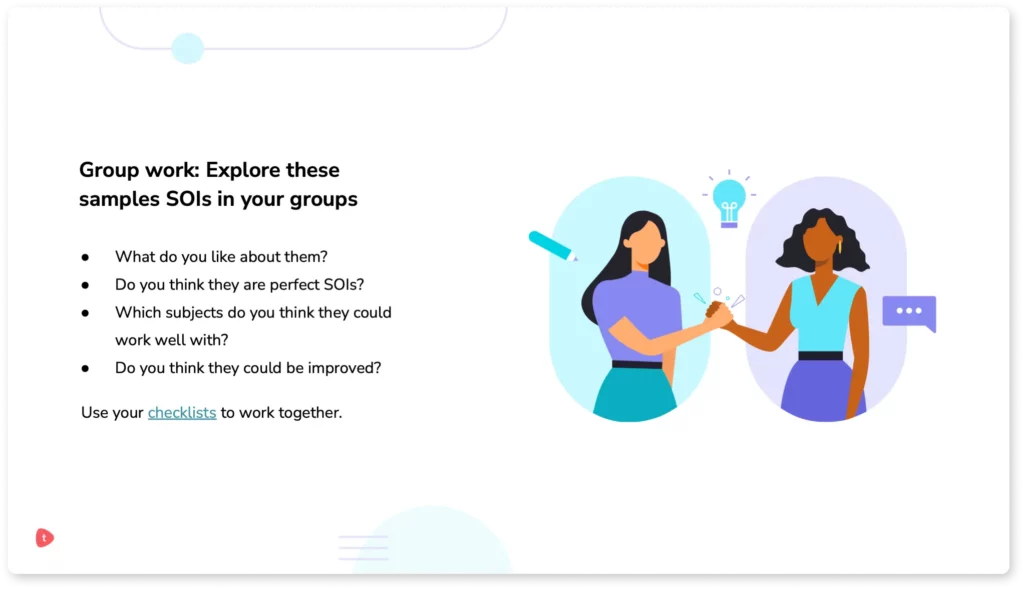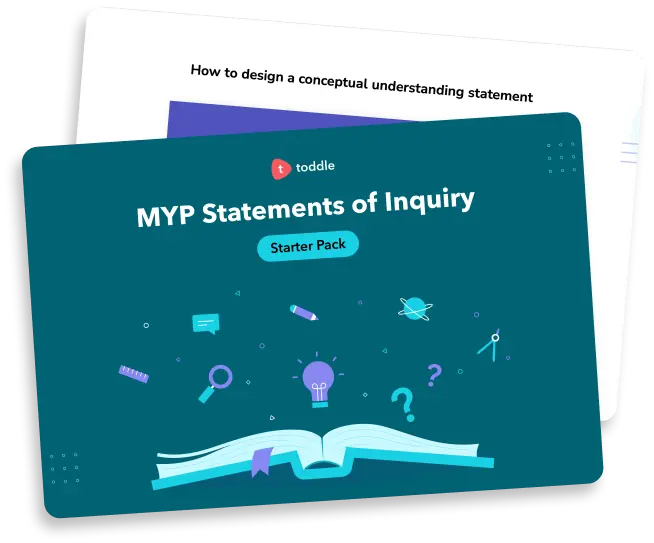MYP Statements of Inquiry Starter Pack
Writing a good statement of inquiry (SOI) for a unit is key. It helps frame the learning and describes the big idea of the unit. This interactive starter pack has been designed to help teaching teams create meaningful SOIs. Featuring an entirely customisable slide deck and checklist, this starter pack can be used by individuals, but is really intended for MYP coordinators or subject coordinators to use with their teachers to help them better understand SOIs. A variety of activities have been suggested below along with instructions for using them with the slide deck and accompanying checklist. Schools often struggle to find time for collaboration, planning and professional development, so this resource can either be used as a short activity (where the leader just presents the information or picks an activity) or for a longer session (where they follow more of the suggested activities). It may also be used before writing a unit to help teachers create a meaningful SOI.
What you will be exploring through this starter pack:
1. What are statements of inquiry (SOIs)?
Before showing teachers the video on slide 4 and the information on slide 5 and slide 6, ask them to describe the purpose and the requirements of the SoIs. You could even get them to create a mindmap to explain what they already know. Get them to include what they think makes a strong SOI.
After they have done this, go through slides 4-6. What new learnings did they have? Did they have any misconceptions? Did anything surprise them? Ask them now to describe the purpose in one sentence.
2. Do our SOIs reflect a big idea?
As you move through the slidedeck with your teams, remind them to always think of the statement of inquiry as a statement that expresses the ‘big idea’ of the unit – the important thing they want students to explore, understand and remember! It might be worth even posting that statement somewhere visible throughout the presentation, for example on flip chart paper.
Consider placing statements of inquiry around the space, on FlipChart paper or printed out, or if you are working online, on a collaborative digital tool like Google Jamboard. You may choose to use your school’s SOIs, or consider taking some from textbooks, partially complete unit planners or Toddle Units. Have your team look at the statements and use the Features of a strong SOI checklist to assess them. You may also refer to the “Is the SOI worth exploring?” slide.
3. How do we construct our SOIs?
Ask teachers how they construct statements of inquiry. Have teachers share the process they go through, including what they feel works and doesn’t work well. You may also want to ask teachers how confident or comfortable they feel with writing SOIs. You could use this information to gauge how their confidence has grown after the session, to partner up confident teachers with less confident, or merely to show teachers that this is something that many people feel under-confident about.
Share the strategy in the slide deck of writing a conceptual understanding statement with the key and related concepts and then using the global context to turn it into a statement of inquiry.
4. How not to go for the obvious
Have teams look at their subject overviews – do they show a balance of global contexts and concepts? Are there any concepts/contexts that are showing up more than others? Why/Why Not? Perhaps science teachers are seeing ‘Scientific and technical innovation’ and language teachers are seeing ‘Communication’ showing up regularly? Have them consider how they might have a better balance by not going for the obvious. Have the teachers brainstorm to come up with ideas for which global contexts and key and related concepts might be better suited for a unit. You can also have teachers use this activity for units that they are feeling bored of – a new focus/lens can give a unit new meaning and life!
You may wish to use the Global Context as a Lens resource to show them how different global contexts (and concepts) can change the direction and theme of a unit. You could even have them think about a unit with the same topic and content, but a completely different set of concepts and contexts and statement of inquiry – how could these things change the focus of the unit? Another activity could be to get teachers to reflect back on their own schooling – what did they learn about? What were the big ideas? Could they write an SOI to summarise what they learnt about when they were younger?
5. How not to make SOIs definitive
Remind teachers that SOIs are not definitive, factual statements and that they may be qualified. A good way to do this is by using words such as ‘may’, ‘can’ ‘could’ or ‘might’. Have teachers look through their SOIs (or those you have provided them to work with) and see if any can be reworded to make them less definitive.
After you have done this, get teachers to think about how they could craft their debatable inquiry question directly from the SOI. For example, turning the SOI “We can take on the perspective of others to create resources that will benefit them” into the debatable question “Is it important to understand our client’s perspective when designing a product to help them?”
6. SOIs and universal transfer
Although SOIs are a great vehicle for making interdisciplinary connections and for helping students connect their learning to the world outside of the classroom, each statement of inquiry does not have to be applicable to every subject and every possible scenario! This would only be possible with very vague phrases! However, there should be some level of transfer. The SOI should connect to a lasting, transferable idea, that the students can see value and meaning in. A way to assess this is to look at the statement of inquiry and reflect using the prompt ‘is this worth exploring?’. Have teachers use this question to reflect on the SOI they just wrote, as well as their existing statements. You can also suggest that this is a question that might be brought into the classroom for students to use for reflection.

Another suggested activity is to have teachers look at different SOIs and brainstorm around them to describe possible connections with other units in their subject, other subjects and outside of the classroom. Although SOIs don’t need to be transferable to every subject and every situation, this is a good exercise to make sure the statements are not too content or subject specific.
7. SOIs for depth and breadth
Have your team look at a statement of inquiry and write two lists. One should be all the big ideas and themes which could connect to the statements. The second list can be discipline specific skills and topics. They may find that the first list helps with breadth and the second with depth.
Teachers can copy this idea with their students by having students discuss the big ideas and themes which connect with the SOI at the start of the unit. At the end of the unit, they can write a list showing all the skills and topics covered in the unit that helped support their understanding of the SOI.
Ask your team the following question:
How might students discuss these SOIs before knowing the content of the unit?
- Solutions designed to benefit the community must first evaluate the community’s ‘needs’, before evaluating their ‘wants’.”
- Changing our pollution management practices can lower ecological footprint and improve our environment.
- Civil rights and social protest movements have led to significant changes in the fairness and equality of societies
Remember that, although content is important, the big idea of the unit is more important for lasting learning.

Unpack SOIs with your teaching teams
Liked this resource ? Here are a few more you might like to explore:
















